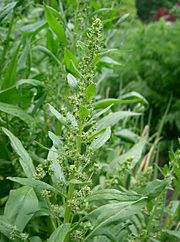Spinacia
| Spinacia subsp. var. | Spinach | |||||||||||||||||||||||||||||||||||||||||||||||||||||||
|---|---|---|---|---|---|---|---|---|---|---|---|---|---|---|---|---|---|---|---|---|---|---|---|---|---|---|---|---|---|---|---|---|---|---|---|---|---|---|---|---|---|---|---|---|---|---|---|---|---|---|---|---|---|---|---|---|

|
|
| ||||||||||||||||||||||||||||||||||||||||||||||||||||||
| ||||||||||||||||||||||||||||||||||||||||||||||||||||||||
Spinacia is the spinach genus.
| Standard Cyclopedia of Horticulture |
|---|
|
Spinacia (from spina; alluding to the spiny fruit). Chenopodiaceae. Spinach. Spinage. According to Volkens (in Engler & Prantl's "Pflanzenfamilien"), there are only two species of Spinacia, S. oleracea, Linn., the common spinach, and S. tetrandra, Stev., although Bentham & Hooker had made the genus to include four species. S. tetrandra is an annual herb of the Asia Minor-Persian region, and is not in cultivation. S. oleracea, the spinach, is probably native to southwestern Asia, and it is now widely cultivated. It is an annual herb, developing rather large arrow-shaped root-leaves, and these leaves are eaten for "greens." Later in the season it sends up a branching flower-stem 2 to 3 feet high, bearing axillary clusters of seed-like fruits. In one type these fruits are spiny: this is the form once described as S. spinosa, Moench, but which is not now considered to be specifically distinct. Whether the round-seeded or the prickly-seeded type is the original form of the spinach is not known, but as a matter of nomenclature, Linnaeus' S. oleracea, which is the oldest name, is held to include all. Spinacia belongs to the Atriplex tribe. The genus is distinguished from Atriplex in the fact that the pistillate flowers are bractless, whereas those of Atriplex are inclosed in a pair of enlarging calyx-like bracts. Spinacia is dioecious, bearing the flowers in small axillary clusters; stamens 4 or 5, in a 4- to 5-lobed calyx; ovary 1, with 4 to 5 styles or stigmas, in a 2- to 4-toothed calyx, this calyx hardening and inclosing the achene and often becoming horned on the sides and giving rise to "prickly-seeded" spinach. The cultivated forms have developed much thicker and broader radical leaves, which are used for greens, often showing little of the halberd or sagittate shape. See Spinach. CH
|
Cultivation
Propagation
Pests and diseases
Species
Gallery
References
External links
- w:Spinacia. Some of the material on this page may be from Wikipedia, under the Creative Commons license.
- Spinacia QR Code (Size 50, 100, 200, 500)
